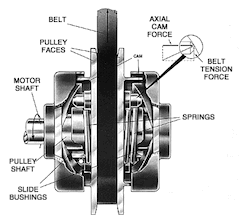Only Hi-Lo Variable Speed Pulley Drives have automatic belt tensioning
Reduce wear on bushings and belts.

The power rating of a variable speed pulley depends on the force it can transmit through a V-belt and companion sheave to a driven shaft. The most common means of providing belt tension is by an axial force applied by a compression spring against the movable flange of the variable speed pulley. The larger the load requirement of a drive, the greater the required belt tension and the greater the required axial force (normally 3 times the effective belt tension).
Variable speed pulleys are often subjected to short duration loads, such as high starting loads and cyclical loads which are considerably larger than normal running loads. To transmit these loads, without slippage or loss of performance, belt tension well in excess of required running load tension must be developed.
However, the more a belt is subjected to the extra tension required for peak loads, the greater the chance to fatigue the belt and other drive components. The efficiency of the drive is also affected adversely.
Automatic Belt Tensioning solves drive fatigue problem.
Hi-Lo pulleys reduce unwanted belt tension by automatically adjusting belt tension with an exclusive cam mechanism. The load requirement itself determines how much axial force and resulting belt tension is needed. Consequently a Hi-Lo Pulley automatically grips the belt tighter at start up and peak loads, then relaxes its grip at normal running loads. Your drives live longer.
When a Hi-Lo Pulley is mounted on a motor shaft, the pulley shaft, with the cam housing attached, becomes integral with the motor shaft. The sliding pulley faces, however, are free to move axially and rotate until the cam followers, due to the effective belt tension, contact the cams. When the belt tension requirement increases, the cam followers rotate up the helical cam ramp causing additional axial pressure between the faces and the belt. The belt is consequently gripped tighter and the increased load can be transmitted without slippage or loss of pitch diameter setting. When the belt tension requirement decreases, there is an opposite reaction and the axial force is reduced.
The cam mechanism also provides peripheral support to the pulley faces and reduces pressure and wear on the sliding face bearing surfaces. The necessity of torque carrying keys in the pulley shaft and slide face are also eliminated and full bearing surface area contact is achieved.
